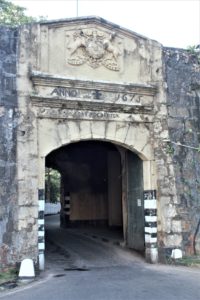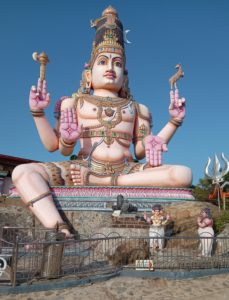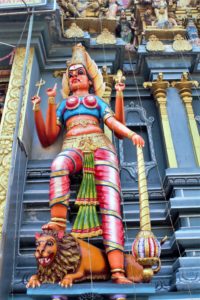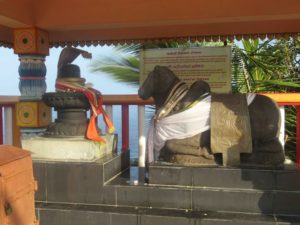One of the main sights in the Sri Lankan port city of Trincomalee, is the Koneswaram Temple which sits on a peninsular high above the sea. To reach it we drove through an impressive narrow arch, the entrance to Fort Fredrick: built by the Portuguese in 1624, it’s now used by the Sri Lankan army and off limits for tourists.
Having parked, we couldn’t help noticing the wild deer roaming around, before we set off on foot along a pedestrianised path lined with stalls selling a range of tourist souvenirs, sweets and temple offerings.
The temple has a strict dress code which included covering shoulders and legs and the removal of shoes. Unfortunately, it was then still a long walk up to the temple, which wasn’t easy on our feet.
The impressive Hindu temple is said to be one of the most important in Sri Lanka yet had an ugly corrugated iron roof which didn’t look particularly effective in keeping out the rain.
The original temple was destroyed in the 17th century during the Portuguese occupation. Valuable artifacts were also stolen, and the priests and pilgrims massacred on site. Those who managed to escape saved a few of the statues, but most of them were lost. The temple was rebuilt in the 20th century. Some of the looted artifacts were found at the bottom of the sea and some were found nearby, buried at the base of the rocks.
Greeting us was an imposing statue of the God Shiva and whilst our guide was keen to explain more about the meaning of all the statues and the murals depicting scenes from the Ramayana, we were more than happy to wander and gaze at the colourful statues, both in and around the temple itself. Sadly photos were not allowed inside.
Worshippers walked around the interior of the temple holding candles in coconut shells which were then discarded in piles on the floor outside.
We were fortunate in that our visit coincided with the 5pm Puja ceremony which involved bare-chested men lighting candles in front of various deities around the temple, and the scattering of petals whilst chanting and ringing a bell.
Outside were lots of small caves with various statues. One sculpture of Nanthi Thevar, a bull, had been discovered in 2013 during excavation work, but dated back to the 11th century.
And of course there were stunning views across the bay.







